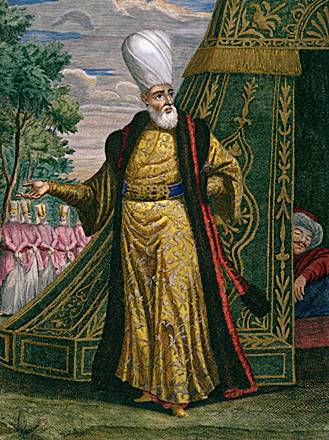|
Tekalif-i Orfiye
Tekalif-i örfiye was a type of taxation in the Ottoman Empire. Tekalif-i orfiye was a blanket terms for several different ad hoc charges which were, initially, extraordinary taxes raised in war-time. They were variously paid in cash or in kind, and rates could vary (to an extent), depending on the community's ability to pay. By the time of the Tanzimat reforms, tekalif-i orfiye included ninety different excise taxes. Tekalif dues became high in the 17th century. However, the Ottoman Empire's complex web of tax exemptions also touched on tekalif; taxpayers could be exempted for public service (for instance, by running a hostel for pilgrims), and sometimes a district's could be exempted due to exceptional hardship (for instance, if the district had already paid heavily towards other taxes, or been ravaged by warfare). Some Janissaries were exempted from tekalif-i orfiye although Janissary status could be effectively hereditary rather than a real military role. A muafname might ex ... [...More Info...] [...Related Items...] OR: [Wikipedia] [Google] [Baidu] |
Ottoman Empire
The Ottoman Empire, * ; is an archaic version. The definite article forms and were synonymous * and el, Оθωμανική Αυτοκρατορία, Othōmanikē Avtokratoria, label=none * info page on book at Martin Luther University) // CITED: p. 36 (PDF p. 38/338) also known as the Turkish Empire, was an empire that controlled much of Southeast Europe, Western Asia, and North Africa, Northern Africa between the 14th and early 20th centuries. It was founded at the end of the 13th century in northwestern Anatolia in the town of Söğüt (modern-day Bilecik Province) by the Turkoman (ethnonym), Turkoman tribal leader Osman I. After 1354, the Ottomans crossed into Europe and, with the Ottoman wars in Europe, conquest of the Balkans, the Ottoman Anatolian beyliks, beylik was transformed into a transcontinental empire. The Ottomans ended the Byzantine Empire with the Fall of Constantinople, conquest of Constantinople in 1453 by Mehmed the Conqueror. Under the reign of Sule ... [...More Info...] [...Related Items...] OR: [Wikipedia] [Google] [Baidu] |
Tanzimat
The Tanzimat (; ota, تنظيمات, translit=Tanzimāt, lit=Reorganization, ''see'' nizām) was a period of reform in the Ottoman Empire that began with the Gülhane Hatt-ı Şerif in 1839 and ended with the First Constitutional Era in 1876. The Tanzimat era began with the purpose, not of radical transformation, but of modernization, desiring to consolidate the social and political foundations of the Ottoman Empire. It was characterised by various attempts to modernise the Ottoman Empire and to secure its territorial integrity against internal nationalist movements and external aggressive powers. The reforms encouraged Ottomanism among the diverse ethnic groups of the Empire and attempted to stem the tide of the rise of nationalism in the Ottoman Empire. Historian Hans-Lukas Kieser has argued that the reforms led to "the rhetorical promotion of equality of non-Muslims with Muslims on paper vs. the primacy of Muslims in practice"; other historians have argued that the ability ... [...More Info...] [...Related Items...] OR: [Wikipedia] [Google] [Baidu] |
Janissaries
A Janissary ( ota, یڭیچری, yeŋiçeri, , ) was a member of the elite infantry units that formed the Ottoman Sultan's household troops and the first modern standing army in Europe. The corps was most likely established under sultan Orhan (1324–1362), during the Viziership of Alaeddin. Janissaries began as elite corps made up through the devşirme system of child levy, by which Christian Albanians, Romanians, Armenians, Bulgarians, Croats, Greeks and Serbs were taken, levied, subjected to circumcision and conversion to Islam, and incorporated into the Ottoman army. They became famed for internal cohesion cemented by strict discipline and order. Unlike typical slaves, they were paid regular salaries. Forbidden to marry before the age of 40 or engage in trade, their complete loyalty to the Sultan was expected. By the seventeenth century, due to a dramatic increase in the size of the Ottoman standing army, the corps' initially strict recruitment policy was relaxed. C ... [...More Info...] [...Related Items...] OR: [Wikipedia] [Google] [Baidu] |
Muafiyet
Muafiyet was a tax exemption mechanism for Ottoman towns or villages; an individual decree of tax exemption was called a muafname. After a muafname was issued to a town, the urban population would be exempted from some of the taxes on ''raya'', such as resm-i çift. Taxation in the Ottoman Empire was complex, including various routine and extraordinary taxes, and different rates for social groups; a muafname might apply to one or more of these taxes. The Muafiyet system was a deliberate policy of the Sublime Porte, working to encourage the growth of urban populations from the 15th century onwards, although forgoing some tax revenue. Tax exemption was prized by locals; so, the granting of a muafname was subject to "pull" as well as "push". Muafname might be requested by the local bey or kadı. Enforcement of the complex patchwork of taxes and exemptions could vary; in one case, taxes were collected from villages despite a muafname, and the local kadı wrote that subsequent legiti ... [...More Info...] [...Related Items...] OR: [Wikipedia] [Google] [Baidu] |
Christianity
Christianity is an Abrahamic monotheistic religion based on the life and teachings of Jesus of Nazareth Jesus, likely from he, יֵשׁוּעַ, translit=Yēšūaʿ, label=Hebrew/Aramaic ( AD 30 or 33), also referred to as Jesus Christ or Jesus of Nazareth (among other names and titles), was a first-century Jewish preacher and religious .... It is the Major religious groups, world's largest and most widespread religion with roughly 2.38 billion followers representing one-third of the global population. Its adherents, known as Christians, are estimated to make up a majority of the population in Christianity by country, 157 countries and territories, and believe that Jesus in Christianity, Jesus is the Son of God (Christianity), Son of God, whose coming as the Messiah#Christianity, messiah was Old Testament messianic prophecies quoted in the New Testament, prophesied in the Hebrew Bible (called the Old Testament in Christianity) and chronicled in the New Testamen ... [...More Info...] [...Related Items...] OR: [Wikipedia] [Google] [Baidu] |

